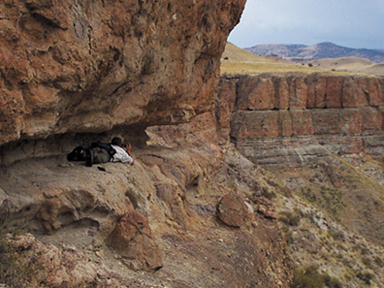
Geotimes Home | AGI Home | Information Services | Geoscience Education | Public Policy | Programs | Publications | Careers

 On a cool autumn
day in November, Ted Fremd and a cadre of volunteer professional paleontologists
embarked on a journey of discovery through the 5- to 50- million-year old fossil
beds in Oregon — just as they do every Monday. That day they found a new
record of tiny insectivores and a primitive marsupial with teeth the size of the
period at the end of this sentence.
On a cool autumn
day in November, Ted Fremd and a cadre of volunteer professional paleontologists
embarked on a journey of discovery through the 5- to 50- million-year old fossil
beds in Oregon — just as they do every Monday. That day they found a new
record of tiny insectivores and a primitive marsupial with teeth the size of the
period at the end of this sentence.  |
Geotimes Home | AGI Home | Information Services | Geoscience Education | Public Policy | Programs | Publications | Careers |